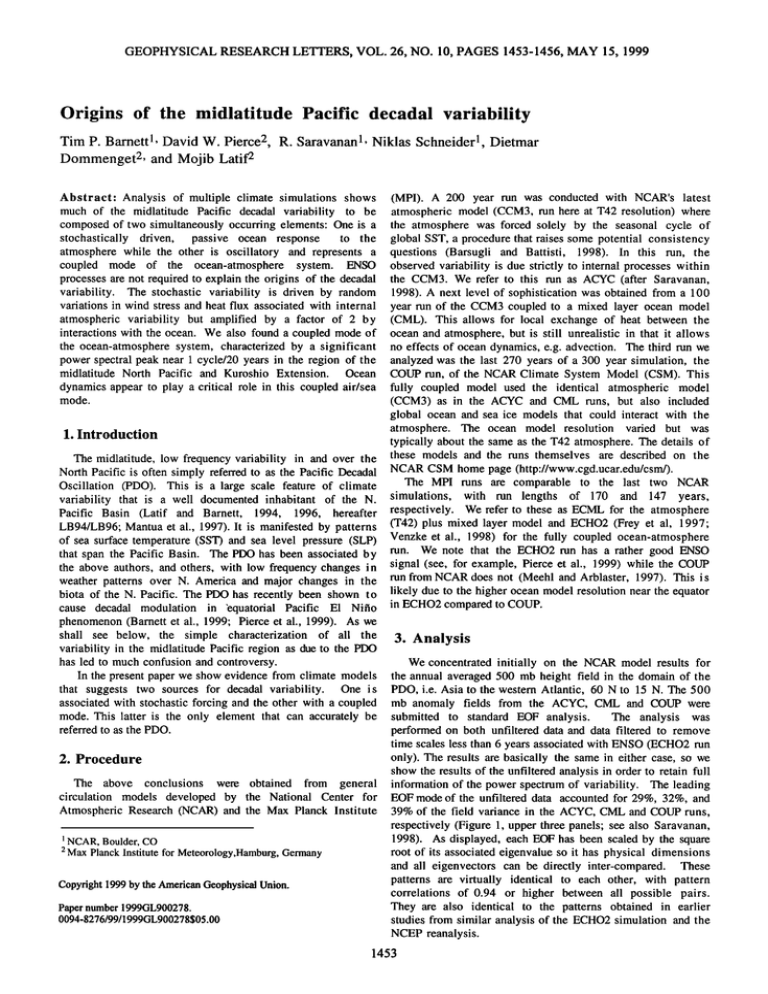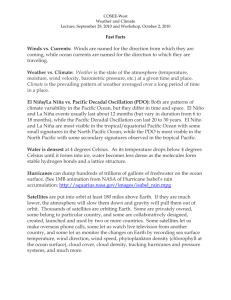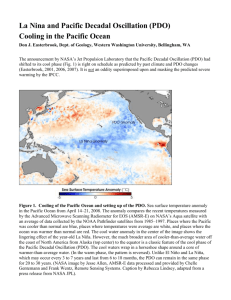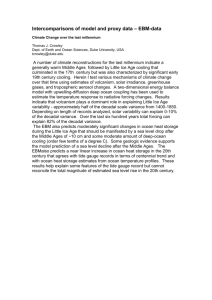Origins of the midlatitude Pacific ... Dommenget 2, and Mojib Latif 2
advertisement

GEOPHYSICAL RESEARCH LETTERS, VOL. 26, NO. 10, PAGES 1453-1456, MAY 15, 1999 Origins of the midlatitude Pacific decadal variability Tim P. Barnett•, DavidW. Pierce2, R. Saravanan •, NiklasSchneider •, Dietmar Dommenget 2, andMojib Latif2 Abstract: Analysis of multiple climate simulations shows much of the midlatitude Pacific decadal variability to be composedof two simultaneouslyoccurringelements: One is a stochastically driven, passive ocean response to the atmospherewhile the other is oscillatory and represents a coupled mode of the ocean-atmosphere system. ENSO processesare not requiredto explain the origins of the decadal variability. The stochastic variability is driven by random variations in wind stress and heat flux associated with internal atmospheric variability but amplified by a factor of 2 by interactionswith the ocean. We also found a coupledmode of the ocean-atmospheresystem, characterizedby a significant power spectralpeak near 1 cycle/20 years in the region of the midlatitude North Pacific and Kuroshio Extension. Ocean dynamicsappear to play a critical role in this coupledair/sea mode. The midlatitude, low frequencyvariability in and over the North Pacific is often simply referredto as the Pacific Decadal Oscillation (PDO). This is a large scale feature of climate variability that is a well documentedinhabitant of the N. Pacific Basin (Latif and Barnett, 1994, 1996, hereafter LB94/LB96; Mantua et al., 1997). It is manifestedby patterns of sea surfacetemperature(SST) and sea level pressure(SLP) that span the Pacific Basin. The PDO has been associatedby the above authors, and others, with low frequencychangesin weather patterns over N. America and major changes in the biota of the N. Pacific. The PDO has recently been shown to cause decadal modulation in •equatorial Pacific E1 Nifio phenomenon(Barnett et al., 1999; Pierce et al., 1999). As we shall see below, the simple characterization of all the variability in the midlatitude Pacific region as dueto the PDO has led to much confusionand controversy. In the presentpaper we showevidencefrom climate models that suggests two sources for decadal variability. One is associatedwith stochasticforcing and the other with a coupled mode. This latter is the only element that can accurately be referred to as the PDO. 2. Procedure The above conclusions were obtained from general circulation models developed by the National Center for Atmospheric Research(NCAR) and the Max Planck Institute MaxPlanck Institute forMeteorology,Hamburg, Germany Copyright1999by theAmericanGeophysical Union. Papernumber1999GL900278. 0094-8276/99/1999GL900278505.00 atmosphericmodel (CCM3, run here at T42 resolution)where the atmospherewas forced solely by the seasonal cycle of globalSST, a procedurethat raisessomepotential consistency questions (Barsugli and Battisti, 1998). In this run, the observedvariability is due strictly to internal processeswithin the CCM3. We refer to this run as ACYC (after Saravanan, 1998). A next level of sophisticationwas obtained from a 100 year run of the CCM3 coupledto a mixed layer ocean model (CML). This allows for local exchange of heat between the ocean and atmosphere,but is still unrealistic in that it allows no effects of ocean dynamics,e.g. advection. The third run we analyzedwas the last 270 years of a 300 year simulation, the COUP run, of the NCAR Climate System Model (CSM). This fully coupled model used the identical atmospheric model (CCM3) as in the ACYC and CML runs, but also included global ocean and sea ice models that could interact with the atmosphere. The ocean model resolution varied but was typically about the sameas the T42 atmosphere.The details of 1. Introduction NCAR,Boulder,CO (MPI). A 200 year run was conductedwith NCAR's latest these models and the runs themselves are described on the NCAR CSM home page (http://www.cgd.ucar.edu/csm/). The MPI runs are comparable to the last two NCAR simulations, with run lengths of 170 and 147 years, respectively. We refer to these as ECML for the atmosphere (T42) plus mixed layer model and ECHO2 (Frey et al, 1997; Venzke et al., 1998) for the fully coupledocean-atmosphere run. We note that the ECHO2 run has a rather good ENSO signal (see, for example, Pierce et al., 1999) while the COUP run from NCAR does not (Meehl and Arblaster, 1997). This i s likely due to the higheroceanmodelresolutionnearthe equator in ECHO2 comparedto COUP. 3. Analysis We concentratedinitially on the NCAR model results for the annual averaged500 mb height field in the domain of the PDO, i.e. Asia to the western Atlantic, 60 N to 15 N. The 500 mb anomaly fields from the ACYC, CML and COUP were submitted to standard EOF analysis. The analysis was performed on both unfiltered data and data filtered to remove time scaleslessthan 6 yearsassociatedwith ENSO (ECHO2 run only). The results are basically the samein either case, so we show the resultsof the unfilteredanalysisin order to retain full informationof the power spectrumof variability. The leading EOF mode of the unfiltered data accountedfor 29%, 32%, and 39% of the field variance in the ACYC, CML and COUP runs, respectively(Figure 1, upperthreepanels;seealso Saravanan, 1998). As displayed,eachEOF has been scaledby the square root of its associatedeigenvalueso it has physical dimensions and all eigenvectors can be directly inter-compared. These patterns are virtually identical to each other, with pattern correlations of 0.94 or higher between all possible pairs. They are also identical to the patterns obtained in earlier studiesfrom similar analysisof the ECHO2 simulation and the NCEP reanalysis. 1453 energetic. So the artificial boundaryconditionsin the ACYC run appreciablydiminishthe magnitudeof the signal (Barsugli 45'N and Battisti, 1998). The signal in the COUP run is due to coupledair/sea interactions that generatepositive feedbacks and a delayed negative feedback provided by slow ocean dynamics,e.g. Pierce et al. (1999). As noted above, the 15'N O' 120'E 150'E 180' 150'W 120'W 90'W pattern strengthin the COUP run is realistic, being nearly 60'N I-] ............... **'* ........ .' '--•..%" *':%* ......•' '%,;•'"2•=*-.-' 45'N :O" "'•""/"*"• '/':.......'"• identicalto that obtained in ECHO2 and the NCEP reanalysis. It is a factor of two lessthan that reportedin LB94. 3. All of the model runs show ENSO processesare not the origins of the decadalvariability as has been conjectured. 15'N Both the ACYC, ECML, and CML runs have no ENSO signal, 120'E 150'E 180' 150'W 120'VV yetproduce realisticdecadalsignals.TheCOUPrunhasdecadal 90'W ... •o., . O' 120'E '• 150'E •.• ....... i...... i ......... !.... .... 180' 150'W 120'W 90'W 2 • , •.... /..•. / ' o_ ß 0.0 0.1 0.2 Frequency(1/years) Figure 1. Leading EOF of 500 mb height anomaly (gpm) for the following experiments, starting from the top: ACYC (AGCM with specifiedSST); CML (AGCM with ocean mixed layer); COUP (full A/OGCM). Bottom panel: normalized spectral density of the projection of the principal components. The cross indicates bandwidth and 95% confidence interval. The next step in the analysis was to project the 500 mb anomalyfield from the ACYC andCML runsonto the leading EOF of the COUP run. The resulting time seriesare referredto as pseudo-principalcomponents(PCs). The purposeof this analysisis to placeall runsinto a singlebasisset. The power spectraof the ACYC andCML pseudo-PCs are shownin Figure 1 (lower) alongwith the spectrumof the COUP PC. The identical set of calculations were done on the MPI variabilityin the tropicalPacific,but virtuallyno ENSO. Yet it alsoproducesa very realisticsignal.The ECHO2 run, although possessed of a reasonable ENSO, produces a PDO patternthatis virtually identical in magnitudeto COUP and the NCEP observations. Clearly, while interactions with the tropics mightfurtherenhancethe midlatitudedecadalvariability, they are clearly not necessaryfor its existence. Indeed, recent resultssuggestjust the opposite' the midlatitudePacific can imposedecadalvariabilityon the ENSO signals(Barnettet al., 1999; Pierce et al., 1999). The degree to which ENSO subsequently impactsthe decadalsignalis an openquestion. 4. The powerspectraof thebasinscale500 mb heightfield principal componentsare statistically 'white', showing that increasingsignal strengthwith increasingmodel complexity is presentat almost all frequencies(Fig. 1). While the large confidencelimits make energy comparisonsat a specific frequencyof questionablevalue, the fact that the energy enhancement is presentat virtuallyall frequencies is muchless likely to happenby chance. 5. There is no evidence of significant, unique spectral peaks in the power spectra of these basin scale features represented by the leadingEOFs. This suggeststhere is no uniquetime scalefor the variability, a resultin keeping with the fundamental originin the atmosphere.While theseresults hold for basin scale atmosphericfeatures,they DO NOT hold more locally (seebelow). There are also theoretical reasonsto believe the basin scale featuresmay be strongly influenced,if not controlled by, ocean featuresof slightly lesser spatial scale (e.g. Weng and Neelin, 1998). We note the earlier analysesof LB94 did not addressthis possibility. 120'E 150'E 180' 150'W 120'W 60'N model runs. Unlessnoted to the contrary, they generally agree with the results found in the NCAR simulations. 40'N 40'N 4. Results 20'N Origins Of The Midlatitude Pacific Decadal Variability 120'E Close inspection of Figure 1 leads to the following conclusions: 1. The PDO-type variability appears in the atmosphere responsein the climatologically forced (ACYC) run. This means its origin is fundamentally atmospheric, since that 150'E 12J_ •\ "i' 180' 150'W 120'W ':' ::Off' •Japan (15o E, 40!N) •8_••/•./\•'.!i ' .... '2' Off Aleutians ,152 W, 52 ', model allows no interaction with the ocean on interannual time scales. Note that even in this case, the pattern has some resemblance to the oft discussedPacific North American (PNA) Pattern (e.g. Hotel and Wallace, 1981), although there are somekey differencesalso. 2. The atmosphericsignalin the CCM3 coupledto a mixed layer (CML) run and COUP run are progressively more 0.0 0.1 0.2 0.3 0.4 0.5 Frequency(cycles/year) Figure2. Top:Ratioof spectral density at a frequency of 20 years/cycle between theCOUP(fullO/AGCM)andCML (ocean mixedlayer)runs.Contourlevelis 0.5 from 1.0 to 5.0, 2.5 thereafter. Lower: ratio of the spectraldensity, at all frequencies, off Japanand theAleutianIslands. 15 The power spectralpeak for SST at about 1 cycle/20 years i s not a statistical fluke nor seen only in the COUP simulation. This is demonstratedin the lower panel of Figure 3 which shows the power spectraof other ocean (heat content, stream function/transport and zonal heat advection) and atmospheric (latent heat flux) variablesoff Japanfor the ECHO2 model. The upper panel showsthe time lagged correlationof the Laplacian of SST off Japan, to be discussedbelow, with increasing eastwardlongitude. The 20 year time scaleis obviousin all the analyses. "',.. ,oLE5 ," • o =J -•0 Feedback -eO 160E 180 160W Longitude '-' '• 10J. ............................. SST r ...... [ 2(J, Years/cyc•e ß --" I • 4[ ' - - - Heat Content I .... Latent Heat FluxI .... - - UdT/dx I l '• 2;;I '""•1' '.1 I lt•,•.:; • .Ill•1!4 ',, 0.00 0.10 0.20 0.30 0.40 0.50 Frequency(cycles/year) Processes The key question is to determine if there is a feedback between the ocean and atmosphere that will allow an oscillatory coupled ocean-atmosphere mode, one that can rightfully be referredto as the PDO. We note that Weng and Neelin (1998) and Munnich et al. (1998) offer a simple theoreticaldescriptionof sucha mode in the presenceof strong stochasticforcing such as describedabove. We demonstratedthe feedback processesas follows: The wind stresscurl pattern associatedwith the 20 year spectral peak in Basin-wideoceanicstreamfunctionwas isolated in the ECHO2 control run by regression analysis. The strongest relation between the two was nearly simultaneous. It is this wind patternthat mustbe driven by the oceanif there is to be anoscillato•coupled mode.We shallreferto thiscurlpattern simply as •'. Figure 3. Lag correlation of low pass filtered Laplacianof The next step was to force the ECHAM4 atmosphericGCM SST at 40N, 150E with similar indices eastwardalong 40N to 160W (upper). Power spectra of ocean and atmospheric (AGCM, Roeckner et al., 1996), the same as usedin ECHO2, variables/processes at 40N, 150E showing a common peak at with specified SST fields that correspondto the two extremes 1 cycle/20 years. The 95% confidencelevel is shown by the of the PDO; one extreme corresponding to a warmer than dashed line (lower). normal Kuroshio extension region, while the other extreme has SST of opposite sign in this region. These SST forcing fields, definedonly above 20N, were taken from the resultsof LB94, but were nearly identical to those producedby COUP or Regional Characteristics ECHO2 and seen in nature. A twelve realization ensemble of AGCM runswascomputedfor eachof the extreme PDO forcing Inspectionof variousregionalpower spectrafor both ocean fields, a total of 2 ensembles and 24 runs. and atmosphericvariablesin the fully coupledruns showed significantpeaksin the midlatitude Pacific and especially the KuroshioExtensionregion at a frequencyof about 1 cycle/20 2o -Phaseof SST Imposed :.-. i I-I years. Twenty years is the circulation time scale of the -in North Pacific: .' ' ! II model's subtropicalgyre. ' -- Warm f"[i JJ Figure 2 showsthe ratio of spectralpower for SST in the 20• 15 year band in the COUP run to the samefrequencyband in the CCM3/slab oceanmodel run. The same signal was seen in the spectralratiosfrom the MPI runs.In regionswherethe ratio i s o 10 high, the additionalvariability must be due to enhancedair/sea o interactionsin the presenceof oceandynamicssincethat is the E only differencebetweenthe model pairs. Clearly the Kuroshio z 5 current, its extension, and the entire subtropical gyre, are deeply involved in the PDO. The variability in the Bering r f'-': •"' I ..... i--IF'i: Sea/Gulfof Alaska is more suspectsince the model has only a I- i ','-r'l , .... 111' i ;,-I',FI, , ,HI , ....... weak subpolargyre and is occasionally impactedby sea ice in ,1.•o-/ _s.•o:e o s.•o-a -'-•.•o-7 the former region. Projection(Pa/m) Tests showedthe spectralpeaks do not come about from Figure 4. Results from the ECHAM4 AGCM forced with the stochastic resonance (Saravanan and McWilliams, 1998), for there is no positive correlation betweenSSTs and net surface PDO SST anomaliesspecifiednorthof 20N only. Shownis the heat flux. As anothertest for purely stochasticeffects,we also projectionof the full wind stresscurl field onto the PDO wind ß , i .... i .... : ...... co,d i i .... i i ii H ' forced the ocean model with randomly shuffled heat and momentumflux field from the full coupledrun. This 137 year long stochastically forcedrun showedno substantial spectral peaks near 1 cycle/20 years. We concludethat the peaks are likely the signatureof dynamic ocean feedbacksof the type describedin LB and more recentlyin Venzke et al., 1998. .... "i[',,-q stresscurlpattern• (described in text) stratifiedby the pattern of anomalous SSTs imposed as a lower boundary condition to the AGCM. Solid line: warm central north Pacific, surroundedby cold anomalies. Broken line: cold central north Pacific, surroundedby warm anomalies.A k/s test shows the two distributions are statistically distinct at a confidence level of 99%. 1456 BARNE'IT ET AL: ORIGINS OF THE MIDLATITUDE PACIFIC DECADAL VARIABILITY The wind stress curl fields from each AGCM ensemble were projected onto the •' pattern and the distribution function of the projection weights computed(Figure4). It was foundthat the two distribution functions are different from each other at simulationswere done at the Climate SimulationLaboratory (CSL) at NCAR. We especiallyappreciatedthe help providedby CSL personnel. Equally generous was the MPI and the German Climate Computing Center for allowing use of their mixed layer and full coupled model runs.We thank LennartBengtssonand Erik Roecknerfor allowing us to usethe ECHAM4 atmosphericmodel and the two anonymousreviewers for helpful comments. the 0.01 level. Further,the centroidof the distributionschange sign with changein the PDO polarity. These facts establishthe responseof the atmosphereto oceaniccirculationchanges.So there is a coupling betweenthe oceanand atmosphereand its References sign dependson the stateof the PDO in the ocean.The senseof the coupling is such as to force an oscillation as described Barnett, T.P., D. Pierce, M. Latif: D. Dommenget, and R. Saravanan, Interdecadalinteractionsbetweenthe tropics and midlatitudesin the below. Pacific Basin, GRL, 26(5), 615-619, 1998. Barnett, T.P. and W. B. White, A servomechanism in Physics of the PDO The models suggest it is the slow changesin meridional gradient,actually the Laplacian,of SST that exerts a torqueon the atmospherethereby altering the curl of the wind stress (Fig. 3, upper), an idea first proposed by Barnett and White (1972). The anomalouscurl so generated, acts to changethe gyre circulation and set in motion, through advection and simple geostrophic adjustment, generation of an anomalous SST field with oppositesignedLaplacian. This change,onceit has become large enough in magnitudeand eastwardextent (Fig. 3, upper) inducesthe oppositesignedcurl pattern and the entire process oscillates. In principle, this is the type of physical scenario envisioned in LB94/96. It is important to note that this set of physics places a heavy burden on the ocean model in simulations of the PDO. Changes in spatial resolution, etc. are apt to affect the simulated general circulation and so give different resultsthan reportedhere. The physicsthat determinesthe time scale is the subject of intense research. There are at least two possibilities. The circulationtime of the gyre is about20 years and sophisticated statistical analysis shows signals propagating completely around the gyre in this interval. These signals may trigger successive oscillations. Alternatively, the several year adjustmenttime of the ocean to changesin the windstresscurl plus the advectiontime scaleneededto add/subtractheat over a large enough area in the Kuroshio extension to affect the Laplacian and subsequently,the atmosphere, also is about 10 years (1/2 cycle). We plan to report in a future note which of these physical scenariossetsthe time scalefor the PDO. In any event, the existenceof a significant20 year spectral peak in two different coupledglobal climate models provides evidence in support of the idea that there is a coupled ocean/atmospheremode of decadalvariability. This mode is seen most strongly in the Kuroshio extension region of the Pacific but also over much of the Basin above 30 N. This is in the ocean/atmosphere systemof the mid-latitudeNorth Pacific, J. Phys. Oceanogr.,2(4), 372-381, 1972. Barsugli, J. and D.S. Battisti, The basic effects of atmosphere-ocean thermalcouplingon midlatitudevariability, J. Atmos.Sci., 55(4), 477493, 1998. Frey, H., M. Latif and T. Stockdale,The coupledGCM ECHO-2. Part I: The tropicalPacific, Mon. Wea. Rev., 125, 703-720, 1997. Horel, J., and J. Wallace, Planetary scale atmospheric phenomena associatedwith the southern oscillation, Mon. Wea. Rev., 829, 1981. 109, 813- Latif, M. and T.P. Barnett,. Causesof decadal climate variability over the North Pacific/North American sector, Science, 266, 634-637, 1994. Latif, M. and T.P. Barnett, Decadal climate variability over the North Pacific and North America: Dynamics and predictability, J. Clim., 9(10), 2407-2423, 1996. Mantua, N.J; S.R. Hare, Y. Zhang, J.M. Wallace, and others,A Pacific interdecadal climate oscillationwith impacts on salmon production, Bull. Am. Met. Soc., 78(6), 1069-1079, 1997. Meehl, GA and J.M. Arblaster, The Asian-Australian monsoon and E1 Nifio SouthernOscillationin the NCAR Climate System Model, J. Clim., 11(6), 1356-1385, 1998. Munnich, M. M. Latif, S. Venzke, and E. Maier-Reimer,. Decadal oscillationsin a simplecoupledmodel, J. Clim., 11(12), 3309-3319, 1998 Pierce, D. W., Barnett, T. P., and Latif, M., Connections between the tropics and midlatitudeson Decadal Time Scales, J. Clim., submitted, 1999. Roeckner, E., K. Arpe, L. Bengtsson,M. Christoph,M. Claussen,L. Dumenil, M. Esch, M. Giogetta, U. Schlese,and U. Schulzweida, The atmospheric general circulation model ECHAM-4: Model description and simulationof present-day climate. Max Planck InstituteRep. No. 218. Available from MPI, Bundestrasse55, D20146 Hamburg, Germany, 1996. Saravanan, R., Atmospheric low-frequency variability and its relationshipto midlatitudeSSTvariability: Studiesusing the NCAR Climate SystemModel. J. Clim., 11(6), 1386-1404, 1998. Saravanan, R. and J.C. McWilliams, Advective ocean-atmosphere interactions:an analytical stochasticmodel with implicationsfor decadalvariability, J. Clim., 11, 165-188, 1998. Weng, W.J. and J.D. Neelin, On the role of ocean-atmosphere interactionin midlatitudeinterdecadal variability, Geophys.Res., Let., 25(2), 167-170, 1998. Venzke, S., M. Muennich, and M. Latif, On predictability of decadal additionto the basin-wide variability forcedstochasticallyby changesin the North Pacific. ClimateDynamics,submitted,1998. the atmosphere,which has no preferredperiod. We suggest that studies which do not carefully separate out these two mechanisms will find conflicting mixtures of physics T.P. Barnett, D.W. Pierce, N. Schneider, Climate Resesarch Division, responsible for Pacific decadalvariability. In principal, only ScrippsInstitutionof Oceanography, 0224, La Jolla,CA 92093. (e-mail: the coupledmode describedaboveoughtto be referred to as the tbarnett@ucsd.edu, dpierce@ucsd.edu, nschneider@ucsd.edu) PacificDecadalOscillation since the stochasticvariability is R. Saravanan, NCAR, P.O. Box 3000, Boulder, CO 80307. (e-mail: simply the passiveocean responseto atmosphericforcing. svn@ucar.edu) Acknowledgments. This work was funded by DOE Grant DEFG03-91-ER61215, NSF Grant ATM-93--14495, NSF Grant OCE97- 11265, the Scripps Institution of Oceanography and the German governmentunder its Decadal Predictabilitygrant. The data were kindly made availablethroughthe courtesyof the NCAR who conceived and conductedthe ACYC and COUP runs analyzed here. The model D. Dommengetand M. Latif, Max Planck Institutefor Meteoroloie, Bundestrasse55, D-20146 Hamburg, Germany. (e-mail: dommenget@dkrz.de,latif@dkrz.de) (Received December 22, 1998); revised March 3, 1999; acceptedApril 6, 1999)




